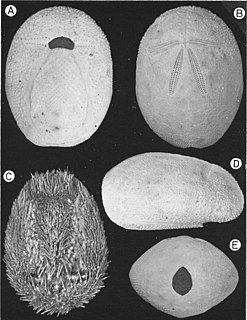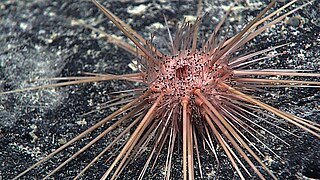Amblypneustes leucoglobus is a species of sea urchin of the family Temnopleuridae. Their armour is covered with spines. It came from the genus Amblypneustes and lives in the sea. Amblypneustes leucoglobus was first scientifically described in 1914 by Ludwig Döderlein.
Aspidodiadema meijerei is a species of sea urchin of the family Aspidodiadematidae. Its armor is covered with spines. It is placed in the genus Aspidodiadema and lives in the sea. Aspidodiadema meijerei was first scientifically described in 1906 by Döderlein.
Aspidodiadema nicobaricum is a species of sea urchin of the family Aspidodiadematidae. Their armour is covered with spines. It is placed in the genus Aspidodiadema and lives in the sea. Aspidodiadema nicobaricum was first scientifically described in 1901 by Döderlein.
Brisaster antarcticus is a species of sea urchins of the Family Schizasteridae. Their armour is covered with spines. Brisaster antarcticus was first scientifically described in 1906 by Döderlein.

Brissus agassizii is a species of sea urchins of the Family Brissidae. Their armour is covered with spines. Brissus agassizii was first scientifically described in 1885 by Döderlein.
Caenopedina alanbakeri is a species of sea urchins of the Family Pedinidae. Their armour is covered with spines. Caenopedina alanbakeri was first scientifically described in 1989 by Rowe.
Caenopedina annulata is a species of sea urchins of the Family Pedinidae. Their armour is covered with spines. Caenopedina annulata was first scientifically described in 1940 by Ole Theodor Jensen Mortensen.
Caenopedina capensis is a species of sea urchins of the Family Pedinidae. Their armour is covered with spines. Caenopedina capensis was first scientifically described in 1923 by Hubert Lyman Clark.
Caenopedina cubensis is a species of sea urchins of the Family Pedinidae. Their armor is covered with spines. Caenopedina cubensis was first scientifically described in 1869 by Alexander Emanuel Agassiz.
Caenopedina depressa is a species of sea urchins of the Family Pedinidae. Their armour is covered with spines. Caenopedina depressa was first scientifically described in 1927 by Koehler.

Caenopedina hawaiiensis is a species of sea urchins of the Family Pedinidae. Their armor is covered with spines. Caenopedina hawaiiensis was first scientifically described in 1912 by Hubert Lyman Clark.
Caenopedina indica is a species of sea urchins of the Family Pedinidae. Their armour is covered with spines. Caenopedina indica was first scientifically described in 1903 by de Meijere.
Caenopedina novaezealandiae is a species of sea urchins of the Family Pedinidae. Their armour is covered with spines. Caenopedina novaezealandiae was first scientifically described in 1964 by Pawson.
Caenopedina otagoensis is a species of sea urchins of the Family Pedinidae. Their armour is covered with spines. Caenopedina otagoensis was first scientifically described in 1968 by McKnight.
Caenopedina porphyrogigas is a species of sea urchins of the Family Pedinidae. Their armour is covered with spines. Caenopedina porphyrogigas was first scientifically described in 2009 by Anderson.
Caenopedina pulchella is a species of sea urchins of the family Pedinidae. Their armour is covered with spines. Caenopedina pulchella was first scientifically described in 1907 by Alexander Emanuel Agassiz and Hubert Lyman Clark.
Caenopedina superba is a species of sea urchins of the family Pedinidae. Their armour is covered with spines. Caenopedina superba was first scientifically described in 1925 by Hubert Lyman Clark.
Calocidaris micans is a species of sea urchins of the Family Cidaridae. Their armour is covered with spines. Calocidaris micans was first scientifically described in 1903 by Ole Mortensen.

Toxopneustes elegans is a species of sea urchin endemic to Japan. Like the closely related flower urchin, they are venomous.

Gracilechinus is a genus of sea urchins in the family Echinidae.






